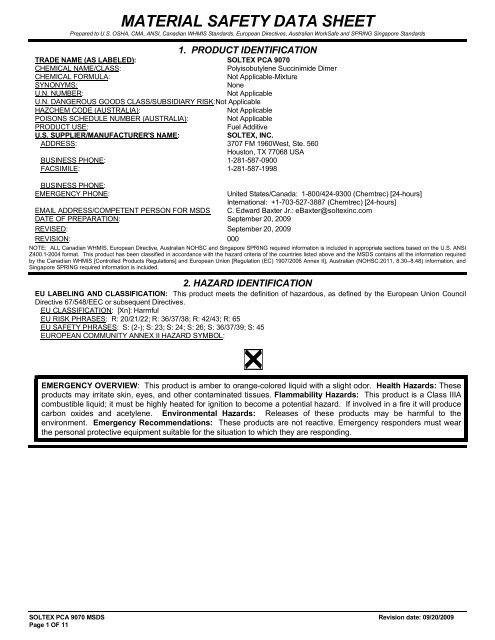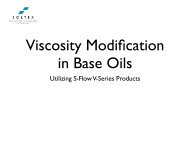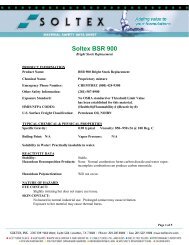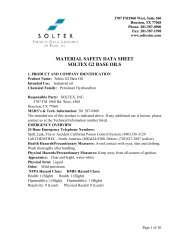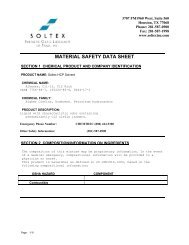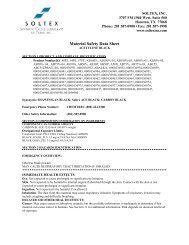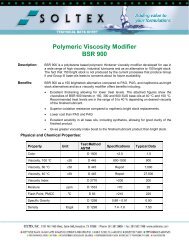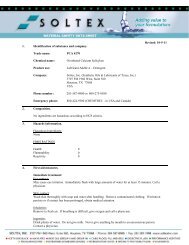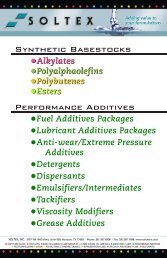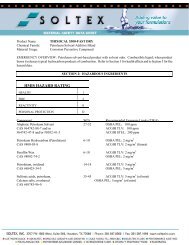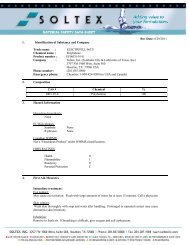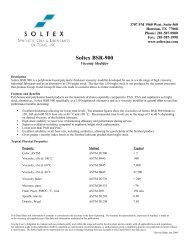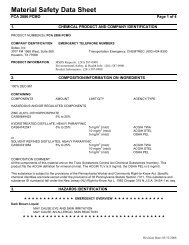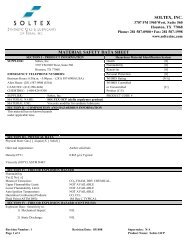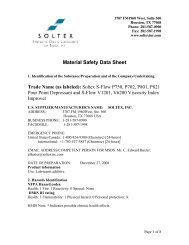MATERIAL SAFETY DATA SHEET - Soltex
MATERIAL SAFETY DATA SHEET - Soltex
MATERIAL SAFETY DATA SHEET - Soltex
You also want an ePaper? Increase the reach of your titles
YUMPU automatically turns print PDFs into web optimized ePapers that Google loves.
<strong>MATERIAL</strong> <strong>SAFETY</strong> <strong>DATA</strong> <strong>SHEET</strong><br />
Prepared to U.S. OSHA, CMA, ANSI, Canadian WHMIS Standards, European Directives, Australian WorkSafe and SPRING Singapore Standards<br />
1. PRODUCT IDENTIFICATION<br />
TRADE NAME (AS LABELED): SOLTEX PCA 9070<br />
CHEMICAL NAME/CLASS:<br />
Polyisobutylene Succinimide Dimer<br />
CHEMICAL FORMULA:<br />
Not Applicable-Mixture<br />
SYNONYMS:<br />
None<br />
U.N. NUMBER:<br />
Not Applicable<br />
U.N. DANGEROUS GOODS CLASS/SUBSIDIARY RISK: Not Applicable<br />
HAZCHEM CODE (AUSTRALIA):<br />
Not Applicable<br />
POISONS SCHEDULE NUMBER (AUSTRALIA):<br />
Not Applicable<br />
PRODUCT USE:<br />
Fuel Additive<br />
U.S. SUPPLIER/MANUFACTURER'S NAME:<br />
SOLTEX, INC.<br />
ADDRESS: 3707 FM 1960West, Ste. 560<br />
Houston, TX 77068 USA<br />
BUSINESS PHONE: 1-281-587-0900<br />
FACSIMILE: 1-281-587-1998<br />
BUSINESS PHONE:<br />
EMERGENCY PHONE:<br />
United States/Canada: 1-800/424-9300 (Chemtrec) [24-hours]<br />
International: +1-703-527-3887 (Chemtrec) [24-hours]<br />
EMAIL ADDRESS/COMPETENT PERSON FOR MSDS C. Edward Baxter Jr.: eBaxter@soltexinc.com<br />
DATE OF PREPARATION: September 20, 2009<br />
REVISED: September 20, 2009<br />
REVISION: 000<br />
NOTE: ALL Canadian WHMIS, European Directive, Australian NOHSC and Singapore SPRING required information is included in appropriate sections based on the U.S. ANSI<br />
Z400.1-2004 format. This product has been classified in accordance with the hazard criteria of the countries listed above and the MSDS contains all the information required<br />
by the Canadian WHMIS [Controlled Products Regulations] and European Union [Regulation (EC) 1907/2006 Annex II], Australian (NOHSC:2011, 8.30–8.48) information, and<br />
Singapore SPRING required information is included.<br />
2. HAZARD IDENTIFICATION<br />
EU LABELING AND CLASSIFICATION: This product meets the definition of hazardous, as defined by the European Union Council<br />
Directive 67/548/EEC or subsequent Directives.<br />
EU CLASSIFICATION: [Xn]: Harmful<br />
EU RISK PHRASES: R: 20/21/22; R: 36/37/38; R: 42/43; R: 65<br />
EU <strong>SAFETY</strong> PHRASES: S: (2-); S: 23; S: 24; S: 26; S: 36/37/39; S: 45<br />
EUROPEAN COMMUNITY ANNEX II HAZARD SYMBOL:<br />
EMERGENCY OVERVIEW: This product is amber to orange-colored liquid with a slight odor. Health Hazards: These<br />
products may irritate skin, eyes, and other contaminated tissues. Flammability Hazards: This product is a Class IIIA<br />
combustible liquid; it must be highly heated for ignition to become a potential hazard. If involved in a fire it will produce<br />
carbon oxides and acetylene. Environmental Hazards: Releases of these products may be harmful to the<br />
environment. Emergency Recommendations: These products are not reactive. Emergency responders must wear<br />
the personal protective equipment suitable for the situation to which they are responding.<br />
SOLTEX PCA 9070 MSDS Revision date: 09/20/2009<br />
Page 1 OF 11
3. COMPOSITION and INFORMATION ON INGREDIENTS<br />
CHEMICAL NAME CAS # EINECS # AICS Inventory Listing % w/v EU/AUSTRALIAN CLASSIFICATION FOR COMPONENTS<br />
Hydrotreated Heavy Paraffinic<br />
Distillate<br />
Amines, polyethylenepoly-, reaction<br />
products with succinic anhydride<br />
polyisobutenyl derivatives (mono<br />
alkkenyl succinimide derivative)<br />
64742-54-7 265-157-1 Listed 10-50% The classification as a carcinogen does not apply as it<br />
has been shown that the substance contains less than<br />
3 % DMSO extract as measured by IP 346.<br />
66762-72-5 Unlisted Unlisted 50-90% Hazard Classification: Not applicable.<br />
Risk Phrases: Not applicable.<br />
Other components which are present in less than 1 percent concentration (or 0.1% concentration<br />
for potential carcinogens, reproductive toxins, respiratory tract sensitizers, and mutagens).<br />
Balance<br />
See Section 15 for full text of Ingredient Risk Phrases for components. See Section 15 for Inventory listing for other countries.<br />
Hazard Classification: Not applicable.<br />
Risk Phrases: Not applicable.<br />
4. FIRST-AID MEASURES<br />
Victims of chemical exposure must be taken for medical attention if any adverse effect occurs. Remove or cover gross<br />
contamination to avoid exposure to rescuers. Rescuers should be taken for medical attention, if necessary. Take a copy of<br />
label and MSDS to health professional with victim.<br />
SKIN EXPOSURE: If this product contaminates the skin, immediately begin decontamination with running water. Minimum<br />
flushing is for 15 minutes. Remove exposed or contaminated clothing, taking care not to contaminate eyes. Victim must<br />
seek medical attention if any adverse effect occurs/continues after flushing.<br />
EYE EXPOSURE: If vapors or liquid from this product enter the eyes, open victim's eyes while under gently running water.<br />
Use sufficient force to open eyelids. Have victim "roll" eyes. Minimum flushing is for 15 minutes. Victim must seek medical<br />
attention if any adverse effect occurs.<br />
INHALATION: If vapors, mists, or sprays of this product are inhaled, remove victim to fresh air. If necessary, use artificial<br />
respiration to support vital functions. Do not use compressed oxygen in hydrocarbon atmospheres. If adverse effect<br />
continues after removal to fresh air, seek medical attention.<br />
INGESTION: If this product is swallowed, CALL PHYSICIAN OR POISON CONTROL CENTER FOR MOST CURRENT<br />
INFORMATION. DO NOT INDUCE VOMITING, unless directly by medical personnel. Have victim rinse mouth with water<br />
or give several cupfuls of water, if conscious. Never induce vomiting or give diluents (milk or water) to someone who is<br />
unconscious, having convulsions, or unable to swallow. If vomiting occurs, lean patient forward or place on left side<br />
(head-down position, if possible) to maintain an open airway and prevent aspiration.<br />
MEDICAL CONDITIONS AGGRAVATED BY EXPOSURE: Acute or chronic respiratory conditions, skin disorders, central<br />
nervous system conditions, or disorders involving the “Target Organs” (see Section 11, “Toxicological Information”) may be<br />
aggravated by overexposure to this product.<br />
RECOMMENDATIONS TO PHYSICIANS: Treat symptoms and eliminate overexposure. Provide oxygen, if necessary.<br />
5. FIRE-FIGHTING MEASURES<br />
FLASH POINT (closed cup, Pensky Martens): 200°C (392°F)<br />
FLAMMABILITY LIMITS: Not established.<br />
AUTOIGNITION: Not determined for product.<br />
FIRE EXTINGUISHING <strong>MATERIAL</strong>S: The following extinguishing<br />
materials are recommended for fires involving this product.<br />
Carbon Dioxide: YES Dry Chemical: YES Other: Any "C" Class<br />
Halon: YES Foam: YES Water Spray: YES (for cooling<br />
only)<br />
FIRE EXTINGUISHING <strong>MATERIAL</strong>S NOT BE USED: None known.<br />
UNUSUAL FIRE AND EXPLOSION HAZARDS: This product is a Class<br />
IIIA combustible liquid. This material can burn but will not readily ignite.<br />
However, if the material is heated above the flash point it can release<br />
vapors that will ignite when exposed to ignition sources. In enclosed<br />
spaces, heated vapor can ignite with explosive force. Mists or sprays<br />
may ignite at temperatures below the flash point. When involved in a fire,<br />
this material may ignite and produce irritating vapors and toxic gases<br />
(e.g., carbon oxides, aromatic and aliphatic hydrocarbons, acetylene).<br />
Explosion Sensitivity to Mechanical Impact: Not sensitive.<br />
Explosion Sensitivity to Static Discharge: If heated, vapors of this product may be ignited by static electrical energy.<br />
SPECIAL FIRE-FIGHTING PROCEDURES: Structural firefighters must wear Self-Contained Breathing Apparatus and full<br />
protective equipment. Chemical resistant clothing may be necessary. Move containers from fire area if it can be done<br />
without risk to personnel. Water spray can be used to cool fire-exposed containers. Water fog or spray can also be used<br />
by trained firefighters to disperse this product’s vapors and to protect personnel. If possible, prevent runoff water from<br />
HEAL TH<br />
entering storm drains, bodies of water, or other environmentally sensitive areas.<br />
thoroughly with soapy water before returning such equipment to service.<br />
NFPA RATING<br />
FL AM MABILIT Y<br />
2<br />
1<br />
OTHER<br />
INSTABIL ITY<br />
Hazard Scale: 0 = Minimal 1 = Slight 2 = Moderate<br />
3 = Serious 4 = Severe<br />
1<br />
Rinse contaminated equipment<br />
SOLTEX PCA 9070 MSDS Revision date: 09/20/2009<br />
Page 2 OF 11
6. ACCIDENTAL RELEASE MEASURES<br />
SPILL AND LEAK RESPONSE: Trained personnel using pre-planned procedures should respond to uncontrolled releases.<br />
Proper protective equipment should be used. In case of a spill, clear the affected area and protect people. Eliminate all<br />
sources of ignition before cleanup begins. Use non-sparking tools. The atmosphere must have levels of components<br />
lower than those listed in Section 8, (Exposure Controls and Personal Protective Equipment), if applicable, and have at<br />
least 19.5 percent oxygen before personnel can be allowed into the area without Self-Contained Breathing Apparatus<br />
(SCBA).<br />
Small Spills: absorb spilled liquid with clay, sand, activated carbon, polypads, or other suitable absorbent materials, wearing gloves,<br />
goggles and apron.<br />
Large Spills: Minimum Personal Protective Equipment should be Level B: triple-gloves (rubber gloves and nitrile gloves over latex<br />
gloves), chemical resistant suit and boots, hard hat, and Self-Contained Breathing Apparatus. For large spills, dike or otherwise<br />
contain spill and remove with vacuum truck or pump to storage/salvage vessels. Decontaminate the area thoroughly. Prevent material<br />
from entering sewer or confined spaces, waterways, soil or public waters. Monitor area for combustible vapor levels and confirm levels<br />
are bellow exposure limits given in Section 8 (Exposure Controls-Personal Protection), if applicable, and that levels are below applicable<br />
LELs (see Section 5 – Fire Fighting Measures) before non-response personnel are allowed into the spill area.<br />
Place all spill residue in a double plastic bag or other containment and seal. Do not mix with wastes from other materials.<br />
Dispose of in accordance with applicable Federal, State, and local procedures (see Section 13, Disposal Considerations).<br />
For spills on water, contain, minimize dispersion and collect. Dispose of recovered material and report spill per regulatory<br />
requirements.<br />
7. HANDLING and STORAGE<br />
SAFE WORK AND HYGIENE PRACTICES: As with all chemicals, avoid getting this product ON YOU or IN YOU. Wash<br />
thoroughly after handling this product. Eye wash stations or safety showers should be near areas where this product is<br />
stored or handled. Do not eat, drink, smoke, or apply cosmetics while handling this product. Avoid breathing vapors or<br />
mists generated by this product. Use in a well-ventilated location. Remove contaminated clothing immediately and launder<br />
before reuse.<br />
STORAGE AND HANDLING PRACTICES: All employees who handle this material should be trained to handle it safely.<br />
Keep away from heat, sparks, and other sources of ignition. Keep container tightly closed when not in use. Use nonsparking<br />
tools. Bond and ground containers during transfers of material. If this product is transferred into another<br />
container, only use portable containers and dispensing equipment (faucet, pump, drip can) approved for combustible<br />
liquids. Store containers in a cool, dry location, away from direct sunlight, sources of intense heat, or where freezing is<br />
possible. Do not store containers above 100°C (212°F). Material stored at cold temperatures may become very viscous<br />
and be difficult to pump. Material should be stored in secondary containers or in a diked area, as appropriate. Store<br />
containers away from incompatible chemicals (see Section 10, Stability and Reactivity). Containers should be separated<br />
from oxidizing materials by a minimum distance of 20 ft. or by a barrier of non-combustible material at least 5 ft. high having<br />
a fire-resistance rating of at least 0.5 hours. Storage areas should be made of fire resistant materials. Post warning and<br />
“NO SMOKING” signs in storage and use areas, as appropriate. Have appropriate extinguishing equipment in the storage<br />
area (i.e., sprinkler system, portable fire extinguishers). Inspect all incoming containers before storage to ensure containers<br />
are properly labeled and not damaged. Refer to NFPA 30, Flammable and Combustible Liquids Code, for additional<br />
information on storage. Empty containers may contain residual liquid or vapors that are flammable; therefore, empty<br />
containers should be handled with care. Never perform any welding, cutting, soldering, drilling, or other hot work on an<br />
empty container or piping until all liquid, vapors, and residue have been cleared.<br />
SPECIFIC USE(S): This product is used in a variety of industrial applications. Follow all industry standards for use of this<br />
product.<br />
PROTECTIVE PRACTICES DURING MAINTENANCE OF CONTAMINATED EQUIPMENT: Follow practices indicated in<br />
Section 6 (Accidental Release Measures). Make certain that application equipment is locked and tagged-out safely, if<br />
necessary. Collect all rinsates and dispose of according to applicable Federal, State, and local procedures standards.<br />
8. EXPOSURE CONTROLS - PERSONAL PROTECTION<br />
VENTILATION, ENGINEERING AND OCCUPATIONAL EXPSOURE CONTROLS: Use with adequate ventilation to ensure<br />
exposure levels are maintained below the limits provided below. Exhaust directly to the outside, taking necessary<br />
precautions for environmental protection. If necessary, refer to Australian National Code of Practice for the Control of<br />
Workplace Hazardous Substances [NOHSC: 2007 (1994)] for further information.<br />
CHEMICAL NAME CAS #<br />
Mono-alkenyl<br />
succinimide<br />
derivative<br />
OCCUPATIONAL EXPOSURE STANDARDS<br />
EXPOSURE LIMITS IN AIR<br />
ACGIH-TLVs OSHA-PELs NIOSH-RELs NIOSH OTHER<br />
TWA STEL TWA STEL TWA STEL IDLH<br />
mg/m 3 mg/m 3 mg/m 3 mg/m 3 mg/m 3 mg/m 3 mg/m 3 mg/m 3<br />
84605-20-9 NE NE NE NE NE NE NE NE<br />
NE = Not Established. SEN = Sensitizer See Section 16 for Definitions of Terms Used.<br />
SOLTEX PCA 9070 MSDS Revision date: 09/20/2009<br />
Page 3 OF 11
The following information on appropriate Personal Protective Equipment is provided to assist employers in complying with<br />
regulations found in U.S. OSHA 29 CFR Subpart I (beginning at 1910.132), equivalent standards of Canada (including<br />
CSA Standard Z94.4-02 and CSA Standard Z94.3-02), standards of EU member states (including EN 529:2005 for<br />
respiratory PPE, CEN/TR 15419:2006 for hand protection, and CR 13464:1999 for face/eye protection), or standards of<br />
Australia (including AS/NZS 1715:1994 for respiratory PPE, AS/NZS 4501.2:2006 for protective clothing, AS/NZS<br />
2161.1:2000 for glove selection, and AS/NZS 1336:1997 for eye protection). Please reference applicable regulations and<br />
standards for relevant details.<br />
RESPIRATORY PROTECTION: If necessary, use only respiratory protection authorized in the U.S. Federal OSHA<br />
Respiratory Protection Standard (29 CFR 1910.134), equivalent U.S. State standards, Canadian CSA Standard Z94.4-02,<br />
the European Standard EN 529:2005, and EU member state standards, the Australian Standard 1716-Respiratory<br />
Protective Devices and Australian Standard 1715-Selection, Use, and Maintenance of Respiratory Protective Devices, or<br />
Singapore standards. Oxygen levels below 19.5% are considered IDLH by OSHA. In such atmospheres, use of a fullfacepiece<br />
pressure/demand SCBA or a full facepiece, supplied air respirator with auxiliary self-contained air supply is<br />
required under OSHA’s Respiratory Protection Standard (1910.134-1998). The following NIOSH Respiratory Protection<br />
Guidelines :<br />
EYE PROTECTION: Wear safety glasses with side shields (or goggles) and a face shield. If necessary, refer to U.S.<br />
OSHA 29 CFR 1910.133, Canadian CSA Standard Z94.3-02, European Standard CR 13464:1999, the Australian<br />
Standard 1337-Eye Protection for Industrial Applications and Australian Standard 1336-Recommended Practices for<br />
Eye Protection in the Industrial Environment, or Singapore standards.<br />
HAND PROTECTION: Wear appropriate gloves to prevent protection against solvents. If material is heated, wear<br />
insulated gloves. Check gloves for leaks. Wash hands before putting on gloves and after removing gloves. If<br />
necessary, refer to U.S. OSHA 29 CFR 1910.138, appropriate Standards of Canada, the Australian Standard 2161-<br />
Industrial Safety Gloves and Mittens, the European Standard CEN/TR 15419:2006, or Singapore standards.<br />
BODY/SKIN PROTECTION: Use body protection appropriate for task (e.g., coveralls or apron). For prolonged or repeated<br />
exposures, use impervious synthetic rubber clothing (boots, gloves, aprons, etc.) over parts of the body subject to<br />
exposure. If handling hot fluid, use insulated protective clothing (boots, gloves, aprons, etc.).<br />
8. EXPOSURE CONTROLS - PERSONAL PROTECTION (Continued)<br />
BODY/SKIN PROTECTION (continued): If necessary, refer to appropriate Standards of Canada, the European Standard<br />
CEN/TR 15419:2006, Australian Standard 3765-Clothing for Protection Against Hazardous Chemicals, or Singapore<br />
standards. If a hazard of injury to the feet exists due to falling objects, rolling objects, where objects may pierce the soles<br />
of the feet or where employee’s feet may be exposed to electrical hazards, use foot protection, as described in U.S. OSHA<br />
29 CFR 1910.136 and the Canadian CSA Standard Z195-02, Protective Footwear.<br />
9. PHYSICAL and CHEMICAL PROPERTIES<br />
RELATIVE VAPOR DENSITY (air = 1): Not established. EVAPORATION RATE (n-BuAc = 1): < 1<br />
MELTING/FREEZING POINT: Not applicable.<br />
BOILING POINT: > 312°C (> 600°F)<br />
SOLUBILITY IN WATER: Insoluble.<br />
SOLUBILITY IN SOLVENTS: Very soluble.<br />
VAPOR PRESSURE @ 20°C: Not established. pH: Not determined, not soluble in water<br />
OXIDIZING PROPERTIES: Not applicable.<br />
SHOCK SENSITIVTY: None.<br />
VISCOSITY DYNAMIC: Not established.<br />
ODOR THRESHOLD: Not established.<br />
VOLATILITY: Not established. SPECIFIC GRAVITY @ 15.5°C: 0.95<br />
FLAMMABILITY LIMITS: Not established.<br />
FLASH POINT (PMCC): >200°C (392°F)<br />
AUTOIGNITION: Not established.<br />
COEFFICIENT OF OIL/WATER DISTRIBUTION (PARTITION COEFFICIENT): Not established.<br />
APPEARANCE, ODOR and COLOR: This product is amber to orange-colored liquid with a slight odor.<br />
HOW TO DETECT THIS SUBSTANCE (warning properties): The odor and appearance of this product may be an<br />
identifying property in event of an accidental release.<br />
10. STABILITY and REACTIVITY<br />
DECOMPOSITION CONDITIONS/STABILITY: Stable under conditions of standard temperature and pressure.<br />
DECOMPOSITION PRODUCTS: Combustion: Carbon oxides, aromatic and aliphatic hydrocarbons, acetylene.<br />
Hydrolysis: Maleic acid.<br />
<strong>MATERIAL</strong>S WITH WHICH SUBSTANCE IS INCOMPATIBLE: This product is incompatible with strong oxidizing agents<br />
(e.g. perchlorates, peroxides, chromates, sodium hypochlorite) ,water (reacts slowly with cold water, rapidly with hot<br />
water, producing heat. forms maleic acid. hot water may cause frothing), alkali metals (e.g. sodium or potassium), alkalis<br />
(e.g. sodium hydroxide or potassium hydroxide), alkaline earth metals (e.g. calcium. magnesium or barium), alkaline<br />
earth hydroxides (e.g. calcium hydroxide), amines (e.g. dimethylamine, triethylamine), pyridine, quinoline, sodium or<br />
potassium carbonates, aqueous ammonia, ammonium hydroxide or ammonium salts, olefins (e.g. ethylene, propylene<br />
or diethylene) and catalysts, strong reducing agents (e.g. phosphorus, tin (ii) chloride, metal hydrides), alcohols.<br />
CONDITIONS TO AVOID: Avoid exposure to or contact with ignition sources, extreme temperatures, direct sunlight and<br />
incompatible chemicals.<br />
11. TOXICOLOGICAL INFORMATION<br />
SOLTEX PCA 9070 MSDS Revision date: 09/20/2009<br />
Page 4 OF 11
IRRITANCY OF PRODUCT: This product may irritate contaminated eyes, skin, mouth, throat, and other contaminated<br />
tissues.<br />
SENSITIZATION TO THE PRODUCT: The mono-alkenyl succinimide component of this product may be a human skin and<br />
respiratory sensitizer; inhalation of this product or skin contact may result in the development of allergy-like respiratory<br />
reactions.<br />
SYMPTOMS OF OVEREXPOSURE BY ROUTE OF EXPOSURE: The most significant routes of occupational<br />
overexposure are contact with the skin and eyes. The symptoms of overexposure to this product are as follows:<br />
INHALATION: If mists or sprays of this product are inhaled, they may irritate the mouth, throat, and other tissues of the<br />
respiratory system. Symptoms may include coughing, sneezing, and difficulty breathing.<br />
CONTACT WITH SKIN or EYES: Depending on the duration and concentration of overexposure, eye contact with vapors<br />
may result in moderate irritation. Direct eye contact with liquid or mist may cause conjunctival irritation. Contact with the<br />
skin may cause irritation of the skin, depending on duration and concentration of contact. Once sensitized, exposure to<br />
very small quantity can cause allergic reaction. Repeated or prolonged contact may produce defatting of the skin leading<br />
to irritation and dermatitis, with symptoms of dryness, redness and cracking.<br />
SKIN ABSORPTION: There is no specific information available on potential<br />
skin absorption of components of this product. Some petroleum distillates<br />
can be absorbed via intact skin; all skin contact should be avoided.<br />
INGESTION: Ingestion is not anticipated to be a significant route of<br />
occupational exposure. If this product is swallowed, it may cause<br />
gastrointestinal irritation and vomiting. Ingestion of large quantities may<br />
be harmful or fatal. Ingestion may lead to aspiration into the lungs.<br />
Aspiration may lead to chemical pneumonitis which is characterized by<br />
pulmonary edema and hemorrhage, and may be fatal.<br />
INJECTION: Accidental injection of this product (via cut or puncture with a<br />
contaminated object) may cause irritation in addition to the wound.<br />
HEALTH EFFECTS OR RISKS FROM EXPOSURE: An Explanation in<br />
Lay Terms. In the event of overexposure, the following symptoms may<br />
be observed.<br />
ACUTE: This product may moderately irritate contaminated eyes. Skin<br />
contact and inhalation can cause irritation of contaminated tissues.<br />
Ingestion of large volumes of this product can be harmful or fatal.<br />
Aspiration of the liquid can cause potentially fatal conditions of<br />
pulmonary edema or chemical pneumonitis.<br />
CHRONIC: Prolonged skin contact may cause dermatitis.<br />
TARGET ORGANS: ACUTE: Skin, eyes, respiratory system, blood,<br />
urinary system. CHRONIC: Skin, respiratory system.<br />
TOXICITY <strong>DATA</strong>: The following toxicology data are available for<br />
components of this product and the product.<br />
PRODUCT:<br />
Eye Irritancy (rabbit) Practically Non-Irritant<br />
Skim Irritancy (rabbit) Practically Non-Irritant<br />
LD 50 (Oral-Rat) > 5000 mg/kg<br />
LD 50 (Skin-Rabbit) > 2000 mg/kg<br />
HYDROTREATED HEAVY PARAFFINIC DISTILLATE:<br />
LD 50 (Oral-Rat) > 15 gm/kg<br />
LD 50 (Skin-Rabbit) > 5 gm/kg<br />
HAZARDOUS <strong>MATERIAL</strong> IDENTIFICATION SYSTEM<br />
HEALTH HAZARD<br />
FLAMMABILITY HAZARD<br />
PHYSICAL HAZARD<br />
Hazard Scale: 0 = Minimal 1 = Slight (YELLOW) 2 = Moderate 1<br />
3 = Serious 4 = Severe * = Chronic hazard<br />
PROTECTIVE EQUIPMENT<br />
EYES RESPIRATORY HANDS BODY<br />
See Section 8<br />
Amines, polyethylenepoly-, reaction products with succinic anhydride<br />
polyisobutenyl derivatives (mono-alkenyl succinimide derivative):<br />
Currently, there are no toxicological data for this compound<br />
CARCINOGENIC POTENTIAL OF COMPONENTS: The components of this product are not found on the following lists:<br />
U.S. EPA, U.S. NTP, U.S. OSHA, U.S. NIOSH, GERMAN MAK, IARC, and ACGIH and therefore are neither considered<br />
to be nor suspected to be cancer-causing agents by these agencies.<br />
REPRODUCTIVE TOXICITY INFORMATION: Listed below is information concerning the effects of this product and its<br />
components on the human reproductive system<br />
Mutagenicity: The components of this product are not reported to produce mutagenic effects in humans.<br />
Embryotoxicity: The components of this product are not reported to produce embryotoxic effects in humans. In tests involving the<br />
Slight evidence of toxicity (reduced body weight gain) was observed in the mothers.<br />
Teratogenicity: The components of this product are not reported to cause teratogenic effects in humans.<br />
Reproductive Toxicity: The components of this product are not reported to cause reproductive effects in humans.<br />
A mutagen is a chemical that causes permanent changes to genetic material (DNA) such that the changes will propagate through generational<br />
lines. An embryotoxin is a chemical that causes damage to a developing embryo (i.e. within the first eight weeks of pregnancy in humans), but<br />
the damage does not propagate across generational lines. A teratogen is a chemical that causes damage to a developing fetus, but the damage<br />
does not propagate across generational lines. A reproductive toxin is any substance that interferes in any way with the reproductive process.<br />
ACGIH BIOLOGICAL EXPOSURE INDICES: Currently, there are no ACGIH Biological Exposure Indices (BEIs) determined<br />
for the components identified of this product.<br />
12. ECOLOGICAL INFORMATION<br />
ALL WORK PRACTICES MUST BE AIMED AT ELIMINATING ENVIRONMENTAL CONTAMINATION.<br />
MOBILITY: This product has not been tested for mobility in soil. It is expected to be highly mobile in soil due to petroleum<br />
derivative components.<br />
SOLTEX PCA 9070 MSDS Revision date: 09/20/2009<br />
Page 5 OF 11<br />
(B LUE)<br />
(RED)<br />
For Routine Industrial Use and Handling Applications<br />
2*<br />
1
PERSISTEANCE AND BIODEGRADABILITY: This product has not been tested for persistence or biodegradability. It is<br />
expected that some biodegradation will occur to this product; however, no specific information is known.<br />
BIO-ACCUMULATION POTENTIAL: This product has not been tested for bio-accumulation potential. No information is<br />
available for components.<br />
ECOTOXICITY: This product has not been tested for aquatic or animal toxicity. All release to terrestrial, atmospheric and<br />
aquatic environments should be avoided.<br />
OTHER ADVERSE EFFECTS: This product does not contain any component with ozone depletion potential.<br />
ENVIRONMENTAL EXPOSURE CONTROLS: Controls should be engineered to prevent release to the environment,<br />
including procedures to prevent spills, atmospheric release and release to waterways.<br />
13. DISPOSAL CONSIDERATIONS<br />
DISPOSAL METHODS: It is the responsibility of the generator to determine at the time of disposal whether the product<br />
meets the criteria of a hazardous waste per regulations of the area in which the waste is generated and/or disposed of.<br />
Waste disposal must be in accordance with appropriate Federal, State, and local regulations. This product, if unaltered by<br />
use, may be disposed of by treatment at a permitted facility or as advised by your local hazardous waste regulatory<br />
authority. Shipment of wastes must be done with appropriately permitted and registered transporters.<br />
DISPOSAL CONTAINERS: Waste materials must be placed in and shipped in appropriate 5-gallon or 55 gallon poly or<br />
metal waste pails or drums. Permeable cardboard containers are not appropriate and should not be used. Ensure that any<br />
required marking or labeling of the containers be done to all applicable regulations.<br />
PRECAUTIONS TO BE FOLLOWED DURING WASTE HANDLING: Wear proper protective equipment when handling<br />
waste materials. Dispose of in accordance with applicable Federal, State, and local procedures and standards.<br />
U.S. EPA WASTE NUMBER: Wastes of this product should be tested to see if they meet the criteria for waste<br />
characteristic ignitability (D001). Testing should be done, per EPA criteria to test wastes to make this determination.<br />
EUROPEAN WASTE CODES: 7: Wastes from the MFSU of Fine Chemicals and Chemical Products Not Otherwise<br />
Specified 07 07 99: wastes not otherwise specified<br />
14. TRANSPORTATION INFORMATION<br />
U.S. DEPARTMENT OF TRANSPORTATION REGULATIONS: This product is NOT classified as dangerous goods, per<br />
U.S. DOT regulations, under 49 CFR 172.101.<br />
TRANSPORT CANADA, TRANSPORTATION OF DANGEROUS GOODS REGULATIONS: This product is NOT classified<br />
as dangerous goods, per regulations of Transport Canada.<br />
INTERNATIONAL AIR TRANSPORT ASSOCIATION SHIPPING INFORMATION (IATA): This product is NOT classified as<br />
dangerous goods, per the International Air Transport Association. Heated product is forbidden to be shipped via aircraft.<br />
INTERNATIONAL MARITIME ORGANIZATION SHIPPING INFORMATION (IMO): This product is NOT classified as<br />
dangerous goods, under rules of the IMO.<br />
IMDG SHIPPING DESCRIPTION: Not regulated.<br />
EUROPEAN AGREEMENT CONCERNING THE INTERNATIONAL CARRIAGE OF DANGEROUS GOODS BY ROAD<br />
(ADR): This product is NOT classified as dangerous goods by the United Nations Economic Commission for Europe.<br />
AUSTRALIAN FEDERAL OFFICE OF ROAD <strong>SAFETY</strong> CODE FOR THE TRANSPORTATION OF DANGEROUS GOODS<br />
BY ROAD OR RAIL: This product is NOT classified as dangerous goods, per regulations of the Federal Office of Road<br />
Safety.<br />
SINGAPORE STANDARD 286: PART A: This product has no requirements under the Specification for Caution Labeling for<br />
Hazardous Substances, Part 4: Marking of Packages, Containers and Vehicles, as it does not meet the criteria for any<br />
hazard class under this regulation.<br />
SOLTEX PCA 9070 MSDS Revision date: 09/20/2009<br />
Page 6 OF 11
15. REGULATORY INFORMATION<br />
ADDITIONAL U.S. REGULATIONS:<br />
U.S. SARA REPORTING REQUIREMENTS: The components of this product are not subject to the reporting requirements<br />
of Sections 302, 304 and 313 of Title III of the Superfund Amendments and Reauthorization Act.<br />
U.S. SARA THRESHOLD PLANNING QUANTITY: The components of this product are NOT subject to specific Threshold<br />
Planning Quantities requirements. The default Federal MSDS submission and inventory requirement filing threshold of<br />
10,000 lb (4,540 kg) may apply, per 40 CFR 370.20.<br />
U.S. SARA HAZARD CATEGORIES (SECTION 311/312, 40 CFR 370-21): ACUTE: Yes; CHRONIC: Yes; FIRE: Yes;<br />
REACTIVE: No; SUDDEN RELEASE: No<br />
U.S. CERCLA REPORTABLE QUANTITY (RQ): No component of this product has a CERCLA RQ.<br />
U.S. TSCA INVENTORY STATUS: The components are listed on the TSCA Inventory.<br />
CLEAN WATER AND OIL POLLUTION ACTS: Not applicable.<br />
CALIFORNIA SAFE DRINKING WATER AND TOXIC ENFORCEMENT ACT (PROPOSITION 65): No component of this<br />
product is listed on the Proposition 65 lists.<br />
ANSI LABELING (Z129.1): MAY CAUSE SKIN AND RESPIRATORY SYSTEM SENSITIZATION AND ALLERGIC<br />
REACTION. CAUSE SKIN, EYE AND RESPIRATORY TRACT IRRITATION. Keep away from heat, sparks, and flame.<br />
Avoid contact with oxidizers or UV light. Avoid breathing vapor or mists. Avoid contact with skin or clothing. Use only with<br />
adequate ventilation. Keep container tightly closed. Wash thoroughly after handling. Wear gloves and goggles. Use only<br />
with adequate ventilation. FIRST-AID: In case of contact, immediately flush skin or eyes for at least 15 minutes with large<br />
amounts of water. If inhaled, move to fresh air. If not breathing, give artificial respiration. If breathing is difficult, give<br />
oxygen. If ingested, do not induce vomiting. Get medical attention immediately. IN CASE OF FIRE: Use fog, foam, dry<br />
chemical or carbon dioxide. IN CASE OF SPILL: Absorb spill with inert material and place in suitable container. Do not<br />
allow contamination of waterways or soil. Refer to Material Safety Data Sheet for additional information on this product.<br />
ADDITIONAL CANADIAN REGULATIONS:<br />
CANADIAN DSL/NDSL INVENTORY STATUS: The components of this product listed the DSL Inventory<br />
OTHER CANADIAN REGULATIONS: Not applicable.<br />
CANADIAN ENVIRONMENTAL PROTECTION ACT (CEPA) PRIORITIES SUBSTANCES LISTS: The components of this<br />
product are not on the CEPA Priority Substances Lists.<br />
CANADIAN WHMIS CLASSIFICATION and SYMBOLS:<br />
Class D2B: Toxic Material Causing Other Toxic Effects<br />
EUROPEAN UNION INFORMATION FOR PRODUCT:<br />
EU LABELING AND CLASSIFICATION: This product is classified as Harmful as defined by the European Union Council Directive<br />
67/548/EEC or subsequent Directives.<br />
EU CLASSIFICATION: Xn [Harmful]<br />
EU RISK PHRASES: [R: 20/21/22]: Harmful by inhalation, in contact with skin and if swallowed. [R: 36/37/38]: Irritating to eyes,<br />
respiratory system and skin. [R: 42/43]: May cause sensitization by inhalation and skin contact. [R: 65]: Harmful: may cause lung<br />
damage if swallowed.<br />
EU <strong>SAFETY</strong> PHRASES: [S: 2]: Keep out of reach of children. [S: 14]: Keep away from oxidizers. [S: 15]: Keep away from heat. [S:<br />
23]: Do not breathe gas/fumes/vapor or spray. [S: 24]: Avoid contact with skin. [S: 26]: In case of contact with eyes, rinse<br />
immediately with plenty of water and seek medical advice. [S: 36/37/39]: Wear suitable protective clothing, gloves and eye/face<br />
protection. [S: 45]: In case of accident or if you feel unwell, seek medical advice immediately (show the label where possible).<br />
EUROPEAN UNION INFORMATION FOR PRODUCT (continued):<br />
EU HAZARD SYMBOLS:<br />
CLASSIFICATION FOR COMPONENTS:<br />
Amines, polyethylenepoly-, reaction products with succinic anhydride polyisobutenyl derivatives (mono-alkenyl succinimide derivative):<br />
An official classification for this substance has not been published in Commission Directives 93/72EEC, 94/69/EC, 96/56/EC, or 98/98/EC or subsequent directives.<br />
Hydrotreated Heavy Paraffinic Distillate:<br />
The following classification has been published in Commission Directives.<br />
EU <strong>SAFETY</strong> PHRASES: [S: 45]: In case of accident or if you feel unwell, seek medical advice immediately (show the label where possible). [S: 53]: Avoid exposure - obtain<br />
special instructions before use.<br />
[Note L]: The classification as a carcinogen does not apply as it has been shown that the substance contains<br />
less than 3 % DMSO extract as measured by IP 346.<br />
SOLTEX PCA 9070 MSDS Revision date: 09/20/2009<br />
Page 7 OF 11
ADDITIONAL AUSTRALIAN RFEGULATIONS:<br />
LABELING AND CLASSIFICATION: This product is classified as Harmful as defined by Australian NOHSC: 1008 (2004).<br />
CLASSIFICATION: Xn [Harmful]<br />
RISK PHRASES: [R: 20/21/22]: Harmful by inhalation, in contact with skin and if swallowed. [R: 36/37/38]: Irritating to eyes,<br />
respiratory system and skin. [R: 42/43]: May cause sensitisation by inhalation and skin contact. [R: 65]: Harmful: may cause lung<br />
damage if swallowed.<br />
<strong>SAFETY</strong> PHRASES: [S: 2]: Keep out of reach of children. [S: 14]: Keep away from oxidizers. [S: 15]: Keep away from heat. [S: 23]:<br />
Do not breathe gas/fumes/vapour or spray. [S: 24]: Avoid contact with skin. [S: 26]: In case of contact with eyes, rinse<br />
immediately with plenty of water and seek medical advice. [S: 36/37/39]: Wear suitable protective clothing, gloves and eye/face<br />
protection. [S: 45]: In case of accident or if you feel unwell, seek medical advice immediately (show the label where possible).<br />
HAZARD SYMBOLS:<br />
AUSTRALIAN INVENTORY OF CHEMICAL SUBSTANCES (AICS) STATUS: The components of this product are listed<br />
on the AICS as given in the table at the end of this Section.<br />
STANDARD FOR THE UNIFORM SCHEDULING OF DRUGS AND POISONS: Not applicable.<br />
ADDITIONAL LABELING INFORMATION: For advice, contact a Poisons Information Centre (Phone eg Australia 131<br />
126; New Zealand 03 4747 000) or a doctor (at once). If swallowed, do NOT induce vomiting.<br />
ADDITIONAL SINGAPORE REGULATIONS:<br />
CODE OF PRACTICE ON POLLUTION CONTROL REQUIREMENTS: The components identified of this product are<br />
NOT subject to the requirements under the Singapore Code of Practice on Pollution Control.<br />
INTERNATIONAL CHEMICAL INVENTORY SUMMARY: The components of this product listed are found on the following<br />
National Chemical Inventories:<br />
INVENTORY NAME<br />
COMPONENT NAME CAS# U.S. TSCA AUSTRALIAN AICS CANADIAN DSL/NDSL EUROPEAN EINECS/ELINCS<br />
Hydrotreated Heavy Paraffinic Distillate 64742-54-7 Yes Yes DSL 265-157-1<br />
Mono-alkenyl Succinimide derivative 84605-20-9 Yes No DSL Unlisted<br />
16. OTHER INFORMATION<br />
The information contained herein is based on data considered accurate. However, no warranty is expressed or implied regarding the accuracy of these data or the results to be obtained from the use<br />
thereof. EnviroFuels LLC assumes no responsibility for injury to the vendee or third persons proximately caused by the material if reasonable safety procedures are not adhered to as stipulated in the<br />
data sheet. Additionally, EnviroFuels LLC assumes no responsibility for injury to vendee or third persons proximately caused by abnormal use of the material even if reasonable safety procedures are<br />
followed. Furthermore, vendee assumes the risk in his use of the material.<br />
SOLTEX PCA 9070 MSDS Revision date: 09/20/2009<br />
Page 8 OF 11


